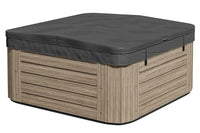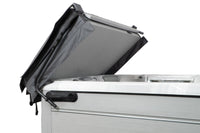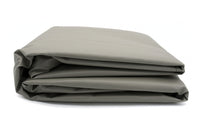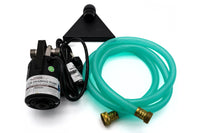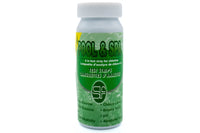A hot tub is a fundamentally simple thing. All it really has to do is hold hot water and people. But of course, water doesn’t heat itself, so the hot tub needs a heater. The people using the tub also leave dirt and oils in the water. That feeds bacteria, which can make the tub smell bad and even harm the health of bathers. You could replace the water every few times you use it, but heating the water is expensive.
You also need a filtration system and anti-bacterial chemicals. Also, it can take hours to heat up a whole tub full of water, and you want to soak when you want to soak. So you will want to keep the tub at bathing temperature all the time. That means a thermostat to control the heater, and top notch thermal insulation for the top and cover, to keep the heat in when you aren’t using it. That simple hot tub is not so simple, anymore.
Some folks are deciding to re-simplify things, though. They are turning back the clock and choosing simplicity and peace over convenience and immediacy. They are choosing to use a wood-fired hot tub. Some of them are even choosing to build their own.
If you’re considering building your own wood-fired tub, there are a few decisions to make long before you pick up the tools.
You’ll need to decide what to make the actual tub out of, first of all. You’ll also need to decide what sort of heating system to use. There are two main types of wood-burning heating systems to choose from, and a bit of ingenuity can turn almost anything into the tub. It just needs to be large enough and be able to hold hot water without leaking.
Choosing Your Tub Material
Although self-built, wood-fired hot tubs aren’t exactly common yet, there are a few trends in choice of tub material among those who have built their own. In the end it’s mostly going to come down to how you want it to look, and how skilled you are with the tools.
Many people are choosing to go with large stock tanks – the kind used to provide water to cattle. These can be found in either rubberized plastic or galvanized steel. The size and shape you choose will depend on how and who will be using it. A thin narrow tank is better for solo soaking, because they are easier to heat and use less water. A round tank works better for when multiple people will be using the tub at the same time.

If you are handy with the tools and insist that the finished product look high-end rather than strictly functional, you can choose to make the tub yourself out of wood. Cedar is a great choice of wood for this. It weathers well, smells great, and swells as it soaks up water, sealing the joins in the boards tightly against leaking. It also looks good, and there’s a pretty good chance you can find a selection that will coordinate with your decking and siding. There are many DIY websites that will guide you through the process of building your own wooden tub. There are also kits available that supply all you need to build your new hot tub.

Choosing Your Heating Method
There are really two ways to heat your wood fired hot tub; with an internal burner, and with an external burner.
An internal burner, often called a snorkel stove, is the most efficient way to heat your tub. The burner is usually made of galvanized aluminum. It is completely sealed except for the top, where the wood goes in and the smoke comes out. The whole unit sits in the water, which allows the entire surface of the sides to transfer heat to the water.
An external burner sits, as the name suggests, outside your tub. It works by piping water from the tub, through pipes that are heated by the fire, and then back into the tub. When properly built, the water circulates through the system by convection. This means you don’t need a pump, but it also means the tub will heat slowly.

Both heating methods are effective, and both mean that you don’t need any electricity to enjoy a nice hot soak. The cover guy recommends that you purchase a specially built wood-fired hot tub heater rather than attempting to build your own from scratch. Unless you are a qualified welder/engineer there is simply too much that could go wrong trying to DIY a wood-burning furnace.
A Simpler Way to Soak
You may have noticed that so far there’s been no mention of filters or chemicals. Because wood-fired tubs are generally smaller than electric tubs, and because they are more “hands on” to use, the water is usually replaced rather than filtered and treated. Using the tub once a day, you can generally expect to drain and refill the tub every week or so. Because the water doesn’t have any of the traditional chemicals added to it, it can be used to water lawns and gardens.
Many people who have switched to a wood burner say that what they really like about them is the sense of ritual involved in their use. They enjoy the process and the effort involved in getting the tub ready for a soak. Studies show that living more intentionally and with greater presence has positive health benefits, so chalk up one more thing in the hot tub win column.
People moving to the Wood Fired Hot Tub also like the idea of no toxic chemicals using only a little hydrogen peroxide to lengthen the use of the water in the tub.
More Building Details
If you do decide to DIY yourself a wood fired hot tub, here are some resources to help you out.
Here’s a breakdown of how to build your own wood fired hot tub. Complete with videos explaining the entire build. How to build a wood fired hot tub. There can be some fairly complicated joinery involved in this one though, so proceed with caution. If you enjoy the rustic, “back yard engineer” aesthetic, here is a pared down version of the stock tank model.
Wood Fired Hot Tub Covers
If you decide that a wood fired hot tub is for you. You will still need a good hot tub cover to help hold in the heat you have created. And also, to keep the debris out of your hot tub. You can build your wood fired hot tub cover here on The Cover Guy website.
Wood Fired Hot Tub
A self-built, wood fired hot tub certainly isn’t for everybody. The building of it can be risky and sometimes difficult, and there’s no guarantee of an attractive, or even a working end product. Running a wood fired hot tub also means less convenience and more effort. For those who make the switch, though, it’s worth it for the sense of self-sufficiency and the back-to-basics feel of the experience. At the end of the day, it’s the experience that matters.

